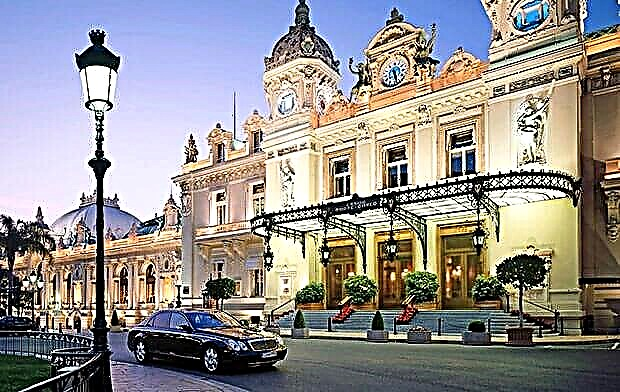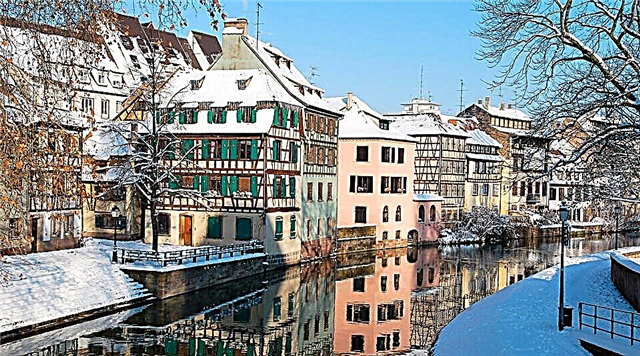Address: Russia, St. Petersburg, Vladimirskaya square
Building: 1761 - 1769 years
Architect: Francesco Rastrelli
Coordinates: 59 ° 55'41.1 "N 30 ° 20'53.7" E
Object of the cultural heritage of the peoples of the Russian Federation
Content:
The five-domed church on the spacious Vladimir Square is one of the ten oldest cathedrals and churches in St. Petersburg. The construction of the Vladimir Cathedral began in the 1761s. In this church, A.S. Pushkin's nanny was buried, and F.M.Dostoevsky prayed. A visit to the cathedral can be combined with a visit to other St. Petersburg sights that are nearby.

View of the Vladimir Cathedral and the bell tower
Temple history
Soon after the founding of the city, the area beyond the Fontanka began to be built up with houses for servants and artisans of the Imperial Court. New streets and lanes formed the Dvortsovaya Sloboda. In 1746, at the corner of Gryaznaya and Kolokolnaya streets, in the house of Fyodor Yakimov, an employee of the Palace Chancellery, a prayer temple with a linen marching iconostasis appeared.
A year later, the old chapel was dismantled at the Liteiny Dvor. The logs were transported to the Trade Square and a wooden church was built from them. It was small and quickly dilapidated, therefore, with the permission of the empress, it was decided to replace the wooden building with a stone one.
For several years, the rector of the church, Father John Kirikov, collected the necessary money from parishioners and patrons of the arts, and in 1761 the long-awaited construction began in the Palace Sloboda. History has not preserved the name of the author of the architectural project. It is believed that it could have been Christian Knobel or Pietro Antonio Trezzini.

View of Vladimirsky Cathedral from Bolshaya Moscow Street
The lower church was completed in 1769, and the upper one in 1783. For its consecration, the stone church received a valuable gift from the empress herself. Catherine II granted the parish the altar Gospel, which was published in 1744.
It so happened that the priest, who made so much effort to build the temple, did not see its opening. Father Ioann Kirikov died earlier and was buried with honors near the church walls.
At the end of the 19th century, the improvement of the temple continued. In 1791, the talented architect Giacomo Quarenghi built a beautiful three-tiered bell tower. In the 1830s, Abraham Melnikov built a vestibule. The architect of His Majesty's Cabinet, Francis Ruska, added a fourth tier to the bell tower building, and a little later, two chapels and a stone fence appeared on the church territory.
The history of the temple has preserved many significant pages. In 1828, a funeral service was held here for the nanny of Alexander Sergeevich Pushkin - his beloved Arina Rodionova. Glorified in the poet's poems, the serf belonged to the Hannibal family. She lived for 70 years and was buried in the city's Smolensk cemetery. Unfortunately, during the years of Soviet power, the grave of Arina Rodionovna was lost.

View of Vladimirsky Cathedral from Vladimirskaya Square
Another sad event took place in 1831. The priests of the temple opel a close friend of A. Pushkin - Baron Anton Antonovich Delvig. The poet and publisher died at the age of 32 from typhus and was buried in the Volkovskoye cemetery.
The Vladimir Church has always played a big role in the lives of believers who lived in the historical center of the city. Under him, a charitable society operated, which contained an orphanage and an almshouse. In 1888, when the 900th anniversary of the Baptism of Rus was celebrated in the Russian Empire, many festive services were held under the vaults of the church.
One of the most famous parishioners of the church is Fyodor Mikhailovich Dostoevsky. The writer lived nearby and rented an apartment in the apartment building of Pryanichnikov, in Kuznechny Lane. At various times, the poet Nikolai Alekseevich Nekrasov, the writer Alexander Ivanovich Kuprin and the composer Nikolai Andreevich Rimsky-Korsakov prayed in the church.
After the 1917 revolution, the fate of many churches and cathedrals in the country changed. During the years of the active struggle of the Soviet government with religion, the Vladimir Church was closed to believers. Fortunately, the solid building remained intact, but to make the golden domes less conspicuous, they were painted over with dark black paint. The Anti-Religious Department of the Public Library is located inside the temple.

View of the southern facade of the Vladimir Cathedral
In the postwar years, the temple premises were occupied by the Lenmashuchet Institute. During the time when strangers were in charge of the church, it lost one of the carved iconostases and all the paintings on the ground floor.
Thanks to the diligence of Lev Nikolaevich Gumilyov and Dmitry Sergeevich Likhachev, in 1989 the old church was returned to the diocese. After that, the church was restored, consecrated, and eight gilded crosses were installed on the domes. In the spring of 2000, it became a cathedral.
Icon of the Virgin
One of the main shrines of the temple is a list from the famous image of the Vladimir Mother of God. This icon came to our country from Byzantium. In the XII century, the Greek Metropolitan Michael from Constantinople came to Kiev and presented it to the son of Vladimir Monomakh - Prince Mstislav Vladimirovich. The venerated image was placed in the Mother of God monastery in Vyshgorod, which was located not far from Kiev.
In 1155, the son of Yuri Dolgoruky, Andrei, transported the icon to himself in Bogolyubovo, and then to the ancient Assumption Cathedral in Vladimir. This is how the old icon got its name - "Vladimirskaya".

Bell tower of Vladimir Cathedral
During the reign of Vasily I, the troops of Tamerlane attacked Russia. To save the shrine, it was hastily transported to Moscow. The Sretensky Monastery was founded in the place where the Muscovites met with the icon, or, as they said at the time, "meeting". For unknown reasons, the warlike Tamerlane refused to seize Moscow and, reaching Yelets, turned back.
Muscovites regarded the miraculous salvation as the intercession of the Mother of Christ, and the icon turned into one of the main Orthodox shrines. In 1930, the original was transferred to the Tretyakov Gallery. Today, the revered image is exhibited in the church-museum of St. Nicholas the Wonderworker in Tolmachi, which has the status of a home church at an art gallery.
Architectural features
The old St. Petersburg Cathedral represents the transition from the traditions of the magnificent Catherine's Baroque to the laconic and strict classicism. In plan, it looks like a square with cut corners. The graceful domes rest on tall cylindrical drums. The facades are richly decorated with pilasters, molded platbands, bow arches and slender Corinthian columns.

View of the domes of the Vladimir Cathedral
To the north of the cathedral stands a magnificent four-tiered bell tower. It has a height of 68 m and ends with a rounded dome and a lantern. The bell tower building looks great from the Trinity Bridge.
Nearby, at the intersection of Dostoevsky Street and Kuznechny Pereulok, there is an apartment museum and a monument to the writer. In honor of the famous parishioner, memorial funeral services are held annually in the temple.
Interior decoration
On the vaults of the main dome, sculptures of the four Evangelists have been preserved. On the second floor, you can see a carved iconostasis of rare beauty, which entered the church in 1808.
This work of art was created by Russian masters based on the drawing of the famous architect Francesco Bartolomeo Rastrelli for the Anichkov Palace. It is noteworthy that there are no more than a dozen of such monuments of the Peter the Great Baroque in our country.

View of the Vladimir Icon of the Mother of God above the entrance to the cathedral
Useful information for visitors
Today the ancient temple has been well restored, and its domes, as before, shine with gilding. The beautiful baroque cathedral has 6 thrones. The lower church is consecrated in honor of the abbot of the Valaam monastery of St. John Damascene, and the upper one is dedicated to the Vladimir Icon of the Mother of God.
Services are held only in the cold part - on the second floor. Visitors go up the stairs there.Church services are held on weekdays at 9:00, and on Sunday and on holidays at 9:00 and 18:00. Every year on July 6, parishioners celebrate a patronal feast in honor of the famous icon.
The church has a church library, a Sunday school, clubs for adults and children, and its own bell ringing school. Everyone really likes the singing of the children's church choir. The doors of the cathedral are open to tourists and pilgrims any day from morning to evening. The entrance to the building is free.

Model of the Vladimir Cathedral
How to get there
The temple complex stands on Vladimirskaya Square, in the Central District of the city. The cathedral occupies the area between Vladimirsky prospect, Kolokolnaya street and Kuznechny lane. Exits from the Vladimirskaya and Dostoevskaya metro stations are nearby. It is easy to walk to the temple from the metro stations "Ploschad Vosstaniya" and "Mayakovskaya".











